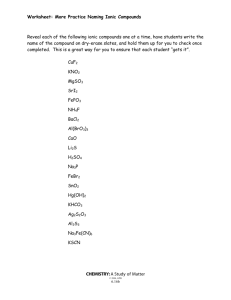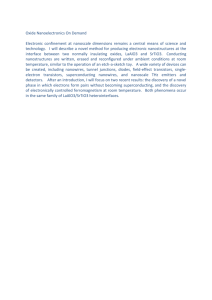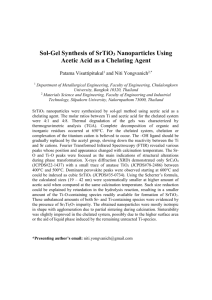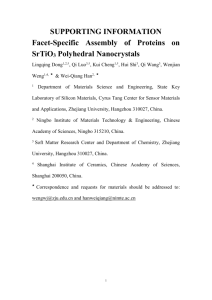FTIR, XRD and AC Impedance Studies of the Polymer
advertisement
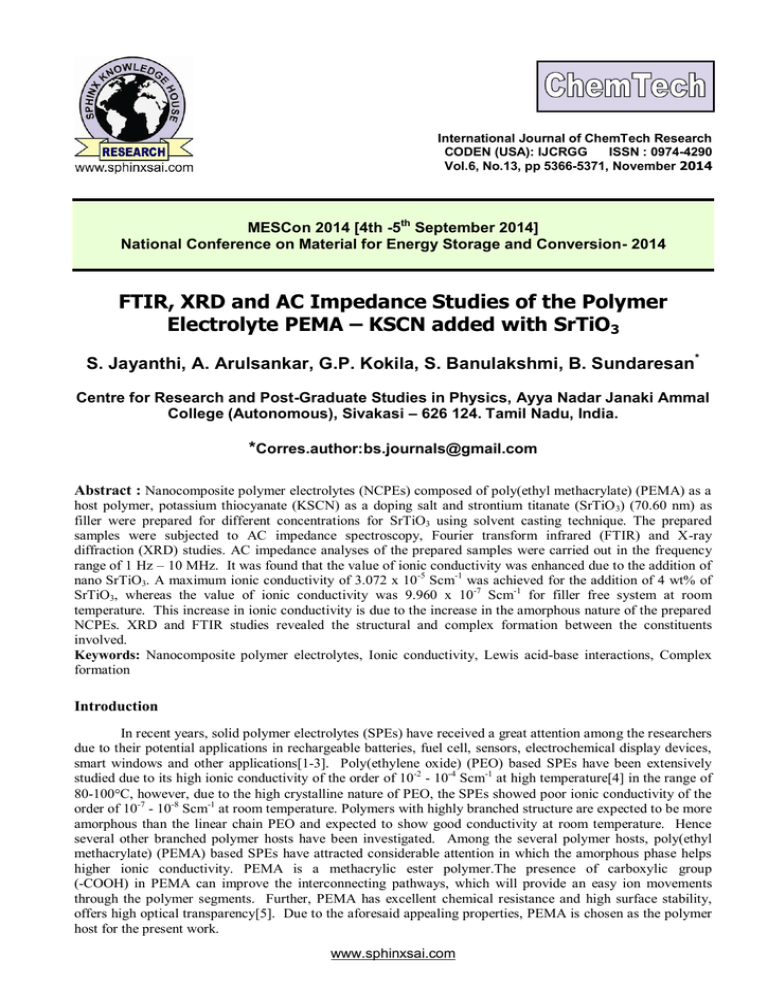
International Journal of ChemTech Research CODEN (USA): IJCRGG ISSN : 0974-4290 Vol.6, No.13, pp 5366-5371, November 2014 MESCon 2014 [4th -5th September 2014] National Conference on Material for Energy Storage and Conversion- 2014 FTIR, XRD and AC Impedance Studies of the Polymer Electrolyte PEMA – KSCN added with SrTiO3 S. Jayanthi, A. Arulsankar, G.P. Kokila, S. Banulakshmi, B. Sundaresan* Centre for Research and Post-Graduate Studies in Physics, Ayya Nadar Janaki Ammal College (Autonomous), Sivakasi – 626 124. Tamil Nadu, India. *Corres.author:bs.journals@gmail.com Abstract : Nanocomposite polymer electrolytes (NCPEs) composed of poly(ethyl methacrylate) (PEMA) as a host polymer, potassium thiocyanate (KSCN) as a doping salt and strontium titanate (SrTiO 3) (70.60 nm) as filler were prepared for different concentrations for SrTiO3 using solvent casting technique. The prepared samples were subjected to AC impedance spectroscopy, Fourier transform infrared (FTIR) and X-ray diffraction (XRD) studies. AC impedance analyses of the prepared samples were carried out in the frequency range of 1 Hz – 10 MHz. It was found that the value of ionic conductivity was enhanced due to the addition of nano SrTiO3. A maximum ionic conductivity of 3.072 x 10-5 Scm-1 was achieved for the addition of 4 wt% of SrTiO3, whereas the value of ionic conductivity was 9.960 x 10-7 Scm-1 for filler free system at room temperature. This increase in ionic conductivity is due to the increase in the amorphous nature of the prepared NCPEs. XRD and FTIR studies revealed the structural and complex formation between the constituents involved. Keywords: Nanocomposite polymer electrolytes, Ionic conductivity, Lewis acid-base interactions, Complex formation Introduction In recent years, solid polymer electrolytes (SPEs) have received a great attention among the researchers due to their potential applications in rechargeable batteries, fuel cell, sensors, electrochemical display devices, smart windows and other applications[1-3]. Poly(ethylene oxide) (PEO) based SPEs have been extensively studied due to its high ionic conductivity of the order of 10-2 - 10-4 Scm-1 at high temperature[4] in the range of 80-100 C, however, due to the high crystalline nature of PEO, the SPEs showed poor ionic conductivity of the order of 10-7 - 10-8 Scm-1 at room temperature. Polymers with highly branched structure are expected to be more amorphous than the linear chain PEO and expected to show good conductivity at room temperature. Hence several other branched polymer hosts have been investigated. Among the several polymer hosts, poly(ethyl methacrylate) (PEMA) based SPEs have attracted considerable attention in which the amorphous phase helps higher ionic conductivity. PEMA is a methacrylic ester polymer.The presence of carboxylic group (-COOH) in PEMA can improve the interconnecting pathways, which will provide an easy ion movements through the polymer segments. Further, PEMA has excellent chemical resistance and high surface stability, offers high optical transparency[5]. Due to the aforesaid appealing properties, PEMA is chosen as the polymer host for the present work. www.sphinxsai.com B. Sundaresan et al /Int.J. ChemTech Res.2014,6(13),pp 5366-5371. 5367 At present, the researchers focused their attention towards the development of advanced battery technologies based on lithium ion batteries. It has been one of the best choices in view of specific capacity and cyclic stability[6]. But the rechargeable lithium ion batteries with high specific power are still unavailable in the market. These batteries are highly expensive and suffer from safety limitations. Hence, new rechargeable battery systems are required which can be made cheap and eco-friendly in nature. Recently, potassium based polymer electrolyte system has gained attention, since it has been found to exhibit several advantages over their lithium counterparts[7]. It is relatively less expensive than lithium. Hence, it is decided to prepare the nanocomposite polymer electrolytes based on PEMA as polymer host, potassium thiocyanate (KSCN) as electrolyte and strontium titanate (SrTiO3) (70.60 nm) as nano filler. Materials and Methods Polyethyl methacrylate (Average molecular weight = 515000 gm/mol) and Strontium Titanate were procured from Aldrich chemicals, USA. Potassium thiocyanate was procured from Himedia, India. The solvent, Tetrahydrofuran was purchased from MERCK, India. All the chemicals were used as received. The polymer electrolyte complexes PEMA-KSCN and PEMA-KSCN-SrTiO 3 are prepared by solvent casting technique using tetrahydrofuran as common solvent. The prepared samples are analyzed to understand the effect of addition of SrTiO3 to PEMA-KSCN complexes, on the structural and electrical properties of the complexes. The samples are characterized using FTIR, XRD and AC impedance techniques. The FTIR spectra were recorded by a SHIMADZU-8400S FTIR Spectrometer, in the region of 400–4000 cm-1 , with a signal average of 20 scans at a resolution of 4 cm -1. X-ray diffraction (XRD) measurements were carried out with XPERT-PRO System. Conductivity studies were carried out by AC Impedance Analyzer Model PSM 1735 supplied by Newtons 4 th Ltd., UK in the frequency range from 1 Hz to 10 MHz and the samples were placed in between two stainless steel electrodes. Results and Discussions FTIR studies FTIR spectroscopy is important in the investigation of polymer structure, since it provides information about the complexation and interactions between the various constituents in the polymer electrolyte. Figure 1(a-e) shows the FTIR spectra of PEMA, KSCN, PEMA-KSCN, SrTiO3 and PEMA-KSCN- SrTiO3 (4wt%) (the NCPE showing maximum ionic conductivity). The vibrational bands at 2985 and 2939 cm-1 in Figure 1(a) are assigned to asymmetric and symmetric C-H stretching of the methylene group of PEMA. The peaks, 1481, 948 and 753 cm-1, correspond to – CH2 scissoring, - CH2 wagging, and- CH2 rocking modes respectively. The C=O carbonyl stretching is observed at 1717 cm-1. The band at 941 cm-1 is due to C-H vibration of C=CH2 group[8]. The FTIR spectrum of KSCN is shown in Figure 1(b). The characteristic peaks at 2052 and 744 cm-1 are assigned to (CN ) and (CS ) vibrational modes of KSCN[9]. The characteristic peaks of PEMA (2985, 2939, 1717, 1481, 1141 cm-1) and KSCN (2052, 744 cm-1) are shifted to (2991, 2925, 1720, 1452, 1118 cm-1) and (2073, 752 cm-1) in KSCN added PEMA (Figure 1c). This confirms the PEMA- KSCN complex formation. The FTIR spectrum of nano SrTiO3 is given in Figure 1(d), which exhibits a peak at 610 cm-1 corresponding to Ti-OI stretching[10]. B. Sundaresan et al /Int.J. ChemTech Res.2014,6(13),pp 5366-5371. 5368 (e) Transmittance (% T) (d) (c) (b) (a) 4000 3500 3000 2500 2000 1500 1000 500 -1 Wavenumber (cm ) Fig. 1 FTIR spectrum of (a) PEMA (b) KSCN (c) PEMA-KSCN (d) SrTiO3 (e) PEMA-KSCN-Sr TiO3 (4wt%) It can be seen from the Figure 1(e), that the vibrational modes of the complex PEMA-KSCN have been influenced due to the addition of nano SrTiO3. The asymmetric and symmetric C-H stretching of methylene group of PEMA observed at 3018 and 2923 cm-1 for the polymer electrolyte are shifted to 3012 and 2928 cm-1 respectively. The - CH2 scissoring mode of PEMA-KSCN at 1452 is shifted to 1458 cm-1. The C=O stretching at 1717 cm-1 for PEMA is shifted to 1720 cm-1 after the addition of KSCN, disappeared after the addition of SrTiO3. This suggests that the carbonyl group of PEMA has directly interacts with the ions of KSCN and SrTiO3. Further, the peak γ(CN) of KSCN in PEMA - KSCN complex shifted from 2073 cm-1 to 2071 cm-1 for SrTiO3 addition. Similar effect has been reported for MgO added polymer electrolyte[11]. The changes in the FTIR spectrum after the addition of the nano SrTiO3 is further explained as follows. The nano SrTiO3 has a Lewis acidic surface group capable of interacting with Lewis base centers of the polymer PEMA. Such interaction improves the amorphous nature of PEMA and also releases more free K + ions. Besides, the SCNanions are well localized in the Lewis acidic sites (O-vacancies) through coordination, which separates the K+ SCN- pairs. These two modes of coordination produce more dissociated K+ ions for charge transport. XRD Analysis X-ray diffraction analysis is very useful in determining the structure of materials. Figure 2 (a-e) shows the X-ray diffraction patterns of samples PEMA, KSCN, PEMA-KSCN, SrTiO3 and PEMA-KSCN-SrTiO3 (4 wt%) respectively. The diffraction peak of PEMA at 2 =18o, Figure 2 (a), agrees well with earlier report[12]. The presence of sharp diffraction peaks in Figure 2 (b and d) indicates the polycrystalline nature of KSCN and SrTiO3 respectively. A comparison of the XRD spectra of PEMA and PEMA-KSCN systems reveals observable differences in the diffraction patterns and hence confirms the complexation between PEMA and KSCN. The diffraction peaks 30o - 40o, clearly apparent in KSCN, are found to be less prominent and shifted to lower angle in PEMAKSCN complex. This could be due to the disruption of PEMA chains by KSCN salt. No shift was observed for the prominent crystalline peaks of the complex, though a reduction in intensity due to the addition of nano SrTiO3 is observed. These observations reveal noteworthy structural reorganization of PEMA after the addition of KSCN and SrTiO3 [13]. B. Sundaresan et al /Int.J. ChemTech Res.2014,6(13),pp 5366-5371. 5369 Fig. 2 XRD patterns of (a) PEMA (b) KSCN (c) PEMA-KSCN (d) SrTiO3, (e) PEMA-KSCN- SrTiO3 (4wt%) AC conductivity studies The AC impedance technique is a versatile tool to characterize the electrical properties of materials. In contrast to DC methods, AC measurements can isolate the individual contributions from the various bulk and interfacial polarization taking place in the electrolyte when stimulated by some external sinusoidal field. The room temperature impedance curve of SrTiO3 based PEMA-KSCN system is shown in Figure 3. The figure shows two well defined regions, a high frequency semicircle related to the parallel combination of a resistor and a capacitor and a low frequency spike representing the formation of double layer capacitance at the electrode – electrolyte interface due to the migration of ions at low frequency. Further, the low frequency response appearing as an inclined spike at an angle less than 90 o to the real axis indicates the inhomogeneous nature of L / Rb , the electrode – electrolyte interface. The ionic conductivities were calculated using the relation where L the thickness of the sample, Rb the bulk resistance and A the area of the electrode used. The estimated ionic conductivity values at room temperature are given in Table 1. It is found from the Table 1 that the value of ionic conductivity for PEMA-KSCN system is 9.96 × 10-7 Scm-1 and it increased when SrTiO3 concentration is raised from 2 wt% to 4wt%. The maximum value of ionic conductivity, 3.072 × 10-5 Scm-1, is observed for 4wt% of addition SrTiO3. This suggests that the introduction of the filler into the electrolyte system influences the electrical behavior of the system by altering the degree of crystallinity of the system. Also, SrTiO 3 filler promotes dissociation of more potassium ions from the inorganic salt KSCN for conduction[14]. Addition of 4wt% of SrTiO3 (optimized concentration) has induced the generation of more cations, K+, to attain higher conductivity. The high dielectric constant of SrTiO3 helped the dissociation of KSCN salt into its respective ions in the polymer matrix[15]. The enhancement in ionic conductivity can also be explained in terms of Lewis acid base interactions. According to Scrosati and co-workers, the Lewis acid groups of the inert filler may compete with Lewis base i.e., the lithium cations for the formation of complexes with the polymer chains as well as the anions of the added lithium salt[16]. Table1 Estimated values of ionic conductivity of PEMA-KSCN and PEMA-KSCN-SrTiO3 system Sample PEMA-KSCN PEMA-KSCN- SrTiO3 (2 wt%) PEMA-KSCN-SrTiO3 (4 wt%) PEMA-KSCN-SrTi O3 (6 wt%) PEMA-KSCN-SrTiO3 (8 wt%) PEMA-KSCN-SrTiO3 (10 wt%) Conductivity (Scm-1) 9.960×10-7 1.184×10-6 3.072×10-5 1.770×10-6 1.020×10-7 3.380×10-6 B. Sundaresan et al /Int.J. ChemTech Res.2014,6(13),pp 5366-5371. 5370 In the present study, the Lewis acid group of the SrTiO3 (i.e. -OH group of SrTiO3) may quietly compete with the Lewis base potassium (K+) cation for the formation of complexes in the PEMA chains as well as with the anions of the KX salt. This will eventually produce structural modifications on the filler surfaces and it may be due to the specific actions of the polar surface groups of the inorganic filler. The centers of the Lewis acid-base interactions react with the electrolytic species thus lowering the ionic coupling and promotes the salt dissociation via a sort of “ion-filler complex” formation and this accounts for the observed enhancement in the ionic conductivity 13. The ionic conductivity is found to decrease for the addition of SrTiO 3 filler above the 4 wt% concentrations. This may be due to the agglomeration of primary particles to bigger particles leading to reduced surface area of the filler and effectively immobilizing the polymer chains[17]. Fig. 3 AC impedance plot of PEMA-KSCN and PEMA-KSCN- SrTiO3 system Conclusions Polymer electrolyte comprising poly (ethyl methacrylate) and potassium thiocyanate was prepared using solvent casting technique. Tetrahydrofuran was used as solvent. Ceramic filler SrTiO3 was added to the polymer electrolyte in the weight ratio from 2 wt% to 10 wt% in steps of 2 wt%. FTIR studies of the polymer electrolyte revealed the complexation between PEMA and KSCN.The addition of SrTiO3 significantly influenced the structure of the complex. X-ray diffraction study of the samples shows the occurrence of structural changes in PEMA due to the addition KSCN and SrTiO 3. It was identified through AC impedance study that the complex with 4wt% of SrTiO3 possessed higher ionic conductivity than SrTiO3 free complex. The ionic conductivity was found to increase by 100 times for the complex added with 4wt% of SrTiO3. This was explained on the basis of Lewis acid base interaction of the system. References 1. 2. 3. 4. 5. 6. 7. 8. 9. 10. 11. 12. Jayanthi S, Kulasekarapandian K, Arulsankar A, Sankaranarayanan K, Sundaresan B. J Compos Mater., DOI: 10.117/0021998314528824. Ramesh S, Ling OP. Polym.Chem., 2010, 1:702. Jayanthi S, Sundaresan B. Ionics, (Article in Press). Ghosh A, Kofinas P. ECS Trans., 2008, 11: 131. Reiter J, Krejza O, Sedlarikova M. Solar Energy Mater Solar Cells., 2009, 93: 249. Tarascon JM, Armand M. Nature., 2001, 414: 359. Dey A, Karan S, De SK. Sol Stat Commun., 2008, 149: 1282. Ulaganathan M, Chitra M. Mathew, Rajendran S. Electrochim Acta., 2013, 93: 230. Kazuo N, Infrared and Raman Spectra of inorganic and co-ordination compounds, New York, John Wiley and sons, 1997, 5th Edition. Last JT. Phys Rev., 1957, 105: 1740. Kumar R, Subramania A, Kalyana Sundaram NT, Vijaya Kumar G, Baskaran I. J Membr Sci., 2007, 300: 104. Rajendran S, Ramesh Prabhu M, Usha Rani M. J Appl Polym Sci., 2008, 110: 2802. B. Sundaresan et al /Int.J. ChemTech Res.2014,6(13),pp 5366-5371. 13. 14. 15. 16. 17. 5371 Wieczork W, Steven JR, Florjanczyk Z. Solid State Ionics, 1996, 85: 67. Ahmad A, Rahman MYA, Ali MLM, Hashim H, Kalam FA. Ionics, 2007, 13: 67. Johansson P, Jacobsson P. Solid State Ionics, 2004, 170: 73. Scrosati B, Croce F, Persi L, Serraino-Fiory F, Plichta E, Hendrickson MA. Electrochim Acta., 2001, 46: 2457. Aravindan V, Vickraman P. Polym Engg Sci., 2009, 49: 2109. *****
